Kazan Kremlin:
The Kazan Kremlin is the chief historic citadel of Tatarstan, situated in the city of Kazan. It was built at the behest of Ivan the Terrible on the ruins of the former castle of Kazan khans. The Kremlin architectural ensemble of the encounter of different cultures was born. In essence, the 18th century reached its present form, but the development of Russian and Tatar traditions, equally important, was and still is based on different cultures and is characterised by the coexistence – both Russian and Tatar, of the Orthodox and Muslim religious traditions. The museum declared a protected historic building complex in 2000 and was included in the UNESCO World Heritage List.

source: http://www.kazan-kremlin.ru/en/gallery/
The Mosque is located on the site of Kazan Kremlin, and is one of the largest in Europe. It was named in honour of the head of the Kazan Khanate Muslims, seid Kul Sharif, who was killed during the defence of the citadel. The complex of the mosque includes the mosque building, library, publishing centre and imam's administration.

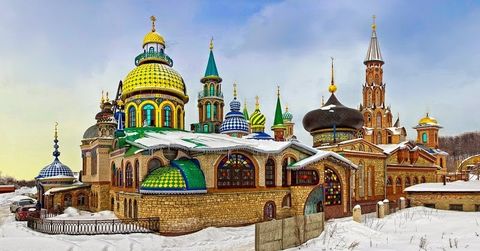
source: http://www.amusingplanet.com/2015/02/the-temple-of-all-religions-in-russia.html
The Kaban Lakes are a system of lakes in Kazan, which includes Nizhny (Blizhny) Kaban, Verkhny Kaban, and Sredny Kaban. With a combined area of 1.86 square kilometres (0.72 sq mi), they include the biggest lake in Tatarstan. The lakes are connected with the Kazanka River by the Bolaq channel and a subterranean channel from Bolaq-Qazansu. They are also connected with the Volga River by the city's sewage system.

source: http://aboutkazan.com/kazan-russia-kaban-lake-photos.shtml
The Märcani Mosque is a mosque in Kazan, built during 1766 to 1770 on Catherine the Great's authority and using the city's population's donations. After several decades of persecution of the Muslims in Imperial Russia the Märcani Mosque was the first mosque built in Kazan under Russian rule. It is the oldest acting mosque in Tatarstan and it was the only mosque in Kazan which escaped closure during the Soviet period.
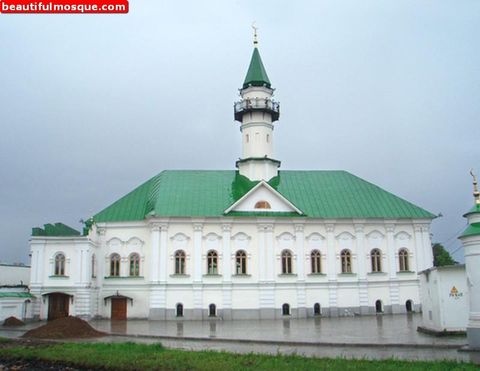
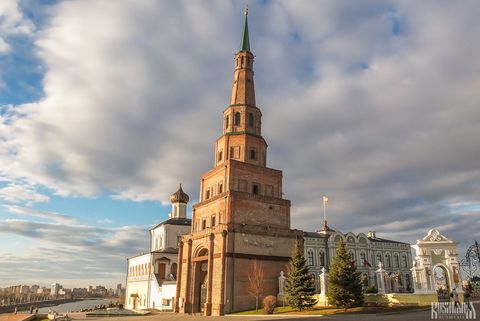

Located in the centre of town, along Lake Kazan, Millennium Park was founded in 2005 during the city’s millennium celebration. In the centre of the park you will find a beautiful fountain, and along its paths many trees, some of which were planted by celebrated local figures. At the entrance, welcoming guests, are bronze dragon statues called Zilants. Millennium Park is the perfect place to relax in the bustling city centre.
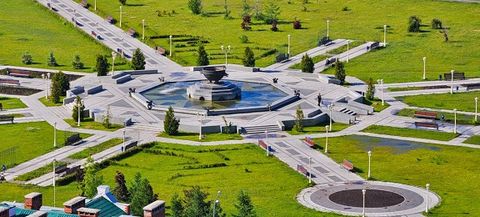
The Nurulla Mosque is a mosque in Kazan. It was built in 1845-1849 with donations from the merchant Ğ. M. Yunısov and as a result of a project by A. K. Loman. The mosque has two storeys, has a hall with cupola and a three-storey cylindrical minaret over the southern entrance. The ornament of the mosque is similar to those of medieval Volga Bulgaria and the Middle East.

Äcem Mosque is a prominent cathedral mosque in Kazan. It is located in the southern part of the Old Tatar Quarter, a historic district populated by Tatars, and is one of about a dozen historical mosques in the district. The construction of the mosque was sponsored by a wealthy Tatar merchant, Mortaza Äcimev, hence the name.
source: https://en.wikipedia.org/wiki/%C3%84cem_Mosque#/media/File:Acem_Mosque.JPG
The Thousandth Anniversary of Islam Mosque or The Anniversary Mosque was built in Kazan to commemorate the thousandth anniversary of the Islamisation of the Volga Bulgars in 922. The alternative name of the mosque, and the most commonly used one, is The Mosque across the Qaban, because most of Kazan's mosques are situated on the other side of the Qaban, where the Tatar community was traditionally located before the October Revolution. The part where the mosque was situated was inhabited predominantly by the Russian community.
Kazan means ‘cup’ or ‘bowl’ and is the basic symbolism of this place, where couples go to get married. It has a great view from the top, where you can see all the major sights of Kazan.
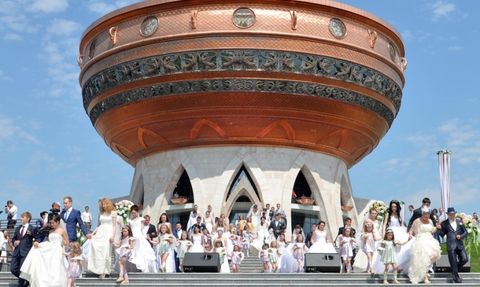
This palace is located in the historic centre of Kazan near the north wall of the Kazan Kremlin. It has become one of the most prominent modern landmarks of the city.
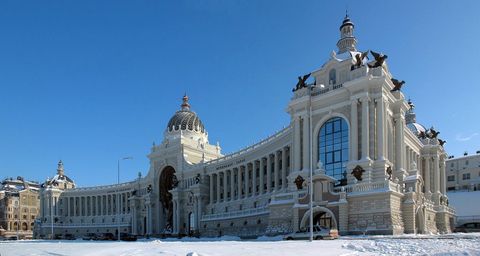
Tatar State Puppet Theatre ‘Ekiyat’ – is one of the oldest theatres in Russia. Its name means ‘fairy tale’. Even if you do not go to see a performance, you can just take a look at the building because it has a very unique architectural style.
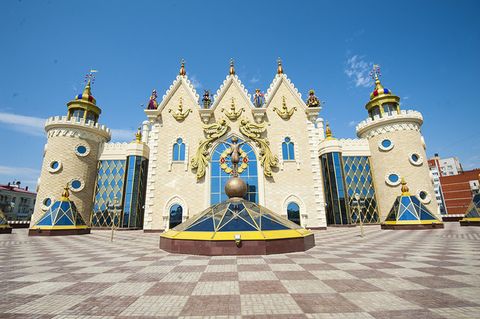
Bauman Street is located in the city centre and is the oldest street, where you can fully experience the diversity of the city. It was named after the famous revolutionary Bolshevik Nikolai Bauman. You can begin your walk from the metro station "Kremlin” and end it near the large clock in the area of Tukaya. Bauman Street is full of amazing discoveries: the church, the bell tower of the Epiphany, the Chaliapin monument, the building of the National Bank, drama theatre, the monument to the Cat of Kazan, zero Meridian, Catherine’s coach, and the alley of national stars.


